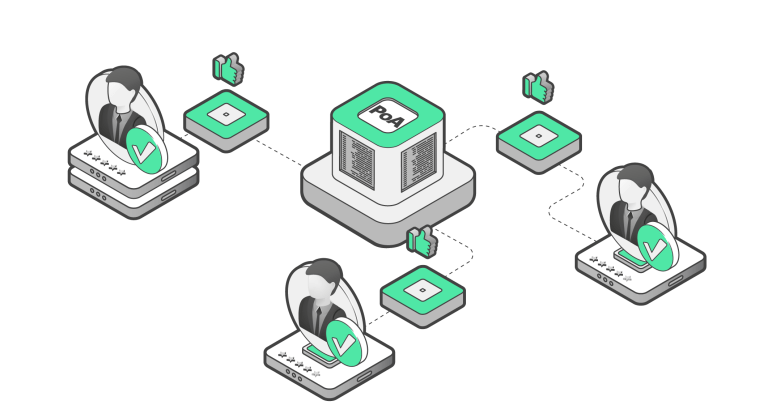Consensus mechanisms are what ensure the security, trust, and overall functioning of a decentralized network. While proof-of-work (PoW) and proof-of-stake (PoS) are the most common, another variant provides a unique blend of centralization and decentralization. It is called proof-of-authority (PoA).
KEY TAKEAWAYS:
- Proof-of-authority (PoA) is a consensus mechanism that relies on a trusted group of people to verify transactions to create new blocks.
- Some of its key features include scalability, low latency, energy efficiency, and centralization.
- PoA has benefits such as lower cost, faster transaction times, and security through accountability.
- Proof-of-authority has found relevance in supply chain management, enterprise solutions, and gaming.
If you’ve heard about PoA and you don’t understand it or its place in the blockchain world, then don’t skip any part of this article. We’ll be examining the proof-of-authority (PoA) mechanism in detail. Furthermore, we’ll highlight its advantages, disadvantages, and applications. Let’s dive in!
What is Proof-of-Authority (PoA)?
PoA is a validation protocol that relies on a small but trusted group of people to verify transactions and create new blocks. These validators or gatekeepers are pre-approved and reputable participants. Also, their identities are public, which helps to hold them accountable for their actions. If they go against the network’s trust, they will lose their position within the ecosystem.
How It Works
In proof-of-authority (PoA), the preapproved validators are selected either by the network’s governing body or by a consensus among existing validators. Below is a quick summary of how the process goes after they have been chosen.
- Block creation: Authorized gatekeepers take turns to add new blocks to the chains. Since there is no staking or complex computations involved, the process is fast and efficient.
- Incentives: Validators receive rewards like transaction fees to secure the blockchains. However, their priority is to maintain their reputation because it is tied to the success or failure of the network.
- Accountability: The gatekeeper’s identities are public, which means they can easily be held accountable for their actions. Any fraud or misconduct that breaches trust would cost them their position.
Key Features of PoA
Unlike PoW or Pos, proof-of-authority relies on the gatekeeper’s identity and reputation. Alongside this, here are other characteristics that set PoA apart:
- Scalability: PoA’s block creation is efficient as a result of the low number of validators. Also, the network processes transactions at a faster rate because it does not require significant computation resources.
- Energy efficiency: You need energy-intensive mining equipment or a large amount of electricity in this consensus mechanism. Thus, it is a greener alternative when compared with proof-of-work.
- Low latency: Since the validation process is streamlined, the transaction times are low. No one is trying to solve complex puzzles or waiting for stakeholders to come to a consensus, leading to prompt verification of transactions.
- Centralization: PoA is more centralized than PoW or PoS because it depends on a small group of validators. While it increased its efficiency, it reduced the decentralization that blockchain is supposed to bring.
Advantages of PoA
Some of the advantages of proof-of-authority include:
- Faster transaction times: Its transactions have much higher throughput because of the absence of computational work.
- Lower costs: It is a cost-effective way to maintain a blockchain since PoA doesn’t need mining equipment.
- Security through accountability: There is a minimized risk of malicious activities because the validators will want to maintain their reputation. Also, there is a reduced risk of 51% attacks.
Disadvantages of PoA
Despite its benefits, PoA is not without its downside. Let’s highlight some of them below:
- Centralization concerns: The network could be compromised if the limited number of validators chose to conspire against the blockchain.
- Validator corruption: While the gatekeepers are publicly known, they are still susceptible to bribery and other types of corruption.
- Limited decentralization: Because control lies with a group of people, other participants might have little influence on decision-making processes.
- Validator selection issues: A biased process of selecting validators can lead to distrust in the network.
Applications of Proof-of-Authority
PoA has found relevance in many real-life industries. Let’s take a look at a few of them.
- VeChain: This is a supply chain management platform that uses blockchain to ensure efficient and scalable operations. VeChain leverages PoA to provide a transparent and authentic track of products on the chain.
- Kovan Testnet: Kovan Testnet uses PoA to test smart contracts on the Ethereum blockchain. This makes it easy for developers to test new features quickly and at a low cost without interacting with the main Ethereum network.
- xDai Chain: This is a stablecoin that is pegged to the American dollar. Because it uses PoA, it delivers fast and cheap transactions. xDai is also used in building highly scalable and efficient decentralized applications (dApps)
- The Sandbox: The Sandbox is a blockchain-based gaming network that uses PoA on its side chain. As such, it allows for secure, faster, and cost-effective transactions.
Summarily
Proof-of-Authority stands as a powerful consensus mechanism that lies between centralization and decentralization. Since it relies on a group of trusted gatekeepers, it ensures fast transaction speed, low costs, and high scalability. PoA currently serves private blockchains like supply chain management and enterprise solutions. However, as it continues to evolve, it is expected that it will help in the development of more efficient decentralized applications.






